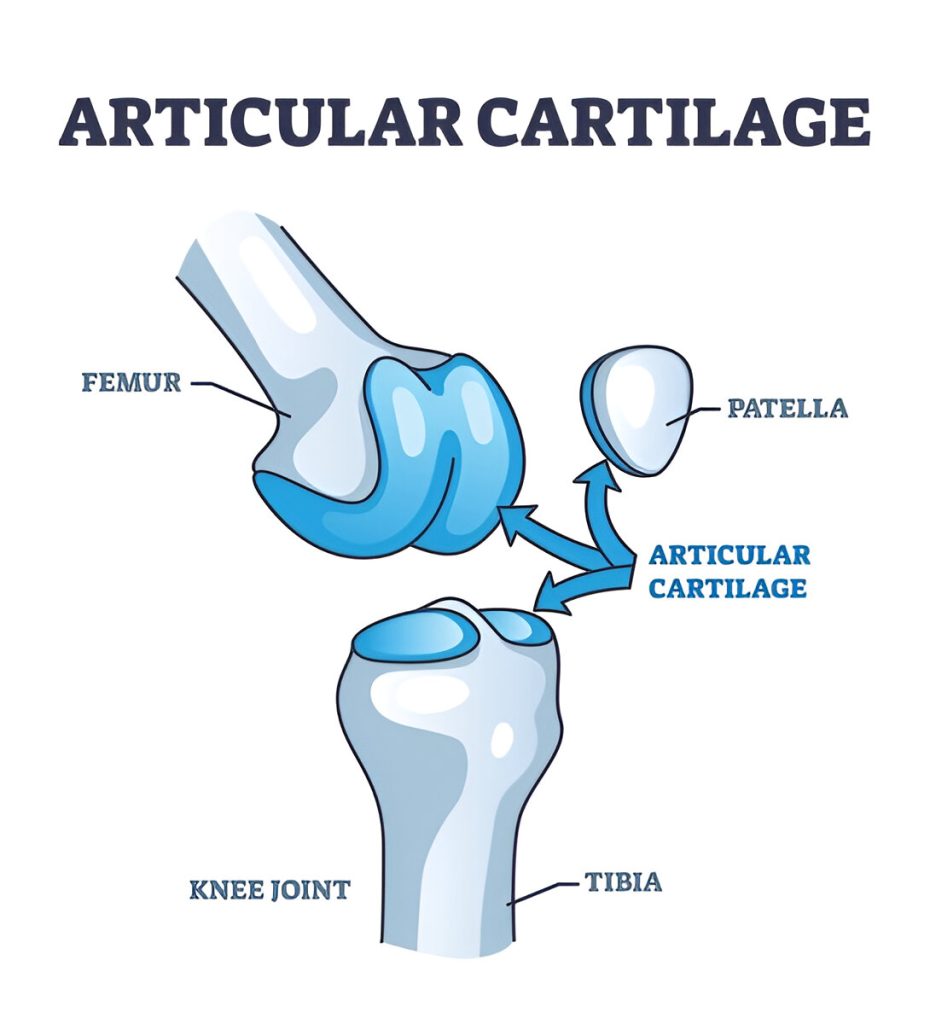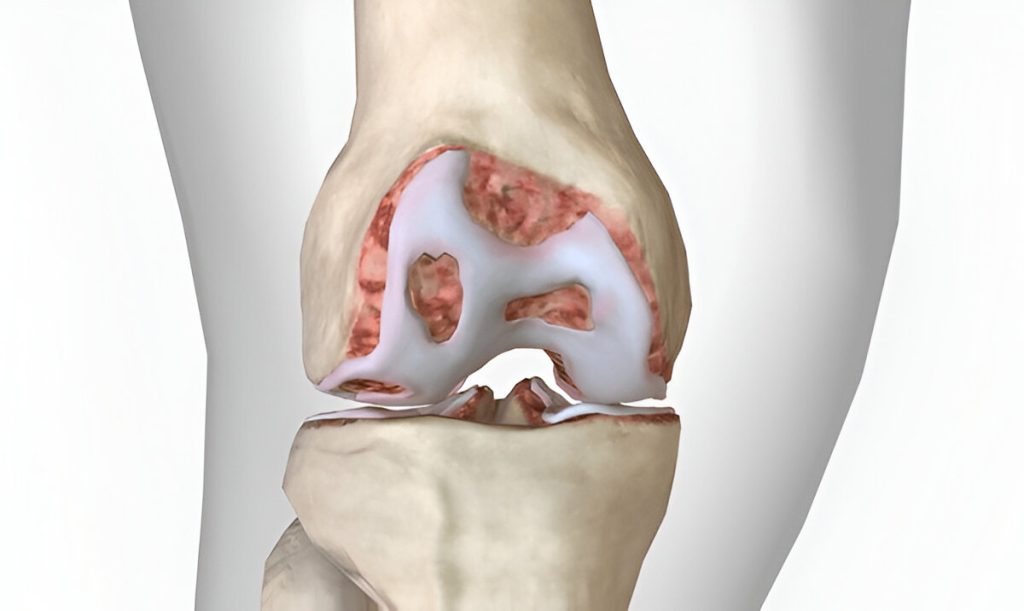Articular Cartilage Injury
Understanding Articular Cartilage
Articular cartilage is a specialized, smooth, white tissue that covers the ends of bones where they meet within a joint—such as the femur, tibia, and patella in the knee. It plays a crucial role in providing a low-friction, shock-absorbing surface that allows the knee joint to glide effortlessly through movement. Remarkably, healthy articular cartilage enables smoother motion than even two pieces of ice sliding over each other.
However, this highly specialized tissue comes with a significant limitation: it has minimal ability to heal on its own. Unlike other tissues in the body, articular cartilage lacks blood vessels, nerves, and lymphatic structures. Its primary caretakers, a sparse population of cells called chondrocytes, are embedded within a dense extracellular matrix made up of collagen and water-attracting molecules called proteoglycans. Because of this structure, once articular cartilage is damaged—whether through trauma or degeneration—repair is limited and complex.
How Cartilage Becomes Injured
Injuries to articular cartilage can occur for a variety of reasons and may affect individuals across a wide range of age groups and activity levels. Common causes include:
Acute trauma: A sudden impact or twisting injury—often from sports, falls, or accidents.
Repetitive stress: Overuse in activities that apply frequent load to the knee (e.g., running, jumping, squatting).
Degenerative changes: Age-related wear and tear, especially in weight-bearing joints like the knee.
Joint instability: Often due to ligament damage such as ACL or meniscus tears, which can create uneven joint forces.
Skeletal malalignment: Improper alignment of the leg can place abnormal stress on certain parts of the knee, accelerating cartilage wear.
Osteochondritis dissecans (OCD): A condition where a piece of bone and cartilage may lose blood supply and break loose from the joint surface.
Injuries can range in severity from softening of the cartilage surface to full-thickness defects that expose the underlying bone.

Focal Articular Cartilage Defects
A focal cartilage defect refers to damage localized to a specific area of the knee’s cartilage. Unlike widespread osteoarthritis, focal defects affect a small portion of otherwise healthy joint cartilage. These lesions are particularly challenging because, despite being localized, they can cause significant pain, swelling, and mechanical symptoms such as locking or catching.
At Kerlan Jobe Institute, we specialize in evaluating and treating focal cartilage injuries using advanced diagnostic tools and a wide array of treatment strategies tailored to each patient’s unique situation.

Symptoms of Articular Cartilage Damage
While cartilage does not have nerve endings, damage to it can still cause a variety of symptoms due to changes in joint mechanics and inflammation of the surrounding tissues. Common symptoms include:
Knee pain (especially during weight-bearing or after prolonged activity)
Swelling or stiffness
Locking or catching sensation during movement
Grinding or popping noises in the joint
Reduced range of motion
Instability or feeling of the knee “giving out”
The intensity of symptoms often depends on the location, size, and depth of the cartilage lesion.
Diagnosis at Kerlan Jobe Institute
A precise diagnosis begins with a comprehensive physical exam and review of the patient’s history. Because many cartilage injuries are not visible on plain X-rays, advanced imaging is often necessary. At Kerlan Jobe Institute, we utilize:
MRI: To assess the cartilage surface and identify soft tissue damage
X-rays: To evaluate bone alignment and exclude arthritis or fractures
Diagnostic Arthroscopy: A minimally invasive surgical procedure used when imaging is inconclusive, allowing direct visualization and treatment
Treatment Options
The management of articular cartilage injuries requires a personalized approach, taking into account the patient’s age, activity level, joint alignment, and extent of the lesion.
Non-Surgical Treatment
Many patients, especially those with small or early-stage defects, respond well to conservative measures:
Activity modification
Physical therapy to strengthen the muscles supporting the joint
Anti-inflammatory medications
Bracing to offload the injured area
Biologic injections (such as Platelet-Rich Plasma [PRP] or viscosupplementation) to reduce inflammation and enhance joint lubrication
Surgical Treatment
When conservative therapy is ineffective, or when defects are larger or symptomatic, surgical intervention may be necessary. At Kerlan Jobe Institute, our orthopedic surgeons are highly skilled in advanced cartilage restoration procedures, including:
Arthroscopic Debridement and Chondroplasty: Smoothing and cleaning damaged cartilage to improve motion
Microfracture: Stimulating new cartilage growth by creating tiny holes in the bone beneath the damaged area
Osteochondral Autograft or Allograft Transplantation (OAT/OCA): Transplanting healthy cartilage and bone from a donor site or cadaver
Autologous Chondrocyte Implantation (ACI): Culturing a patient’s own cartilage cells and implanting them into the defect
Osteotomy: Realigning bones in cases of malalignment to redistribute joint forces
Meniscal Transplantation: Sometimes performed alongside cartilage procedures to restore joint stability
Long-Term Outcomes and Recovery
Recovery from cartilage restoration procedures varies depending on the technique used. In general, rehabilitation involves a carefully structured program with initial weight-bearing restrictions, gradual return to motion, and focused strengthening. Physical therapy is essential and can extend over several months.
When properly diagnosed and treated, many patients can return to a high level of activity, delay the progression of arthritis, and preserve joint health.
Why Choose Kerlan Jobe Institute?
As a nationally recognized leader in sports medicine and orthopedic care, Kerlan Jobe Institute brings together decades of clinical expertise and innovation. Our physicians have pioneered numerous advancements in cartilage restoration and have published extensively on best practices in joint preservation.
Whether you are an athlete with an isolated injury or someone experiencing joint pain from years of wear and tear, our team is dedicated to helping you regain function, reduce pain, and return to the activities you love.
